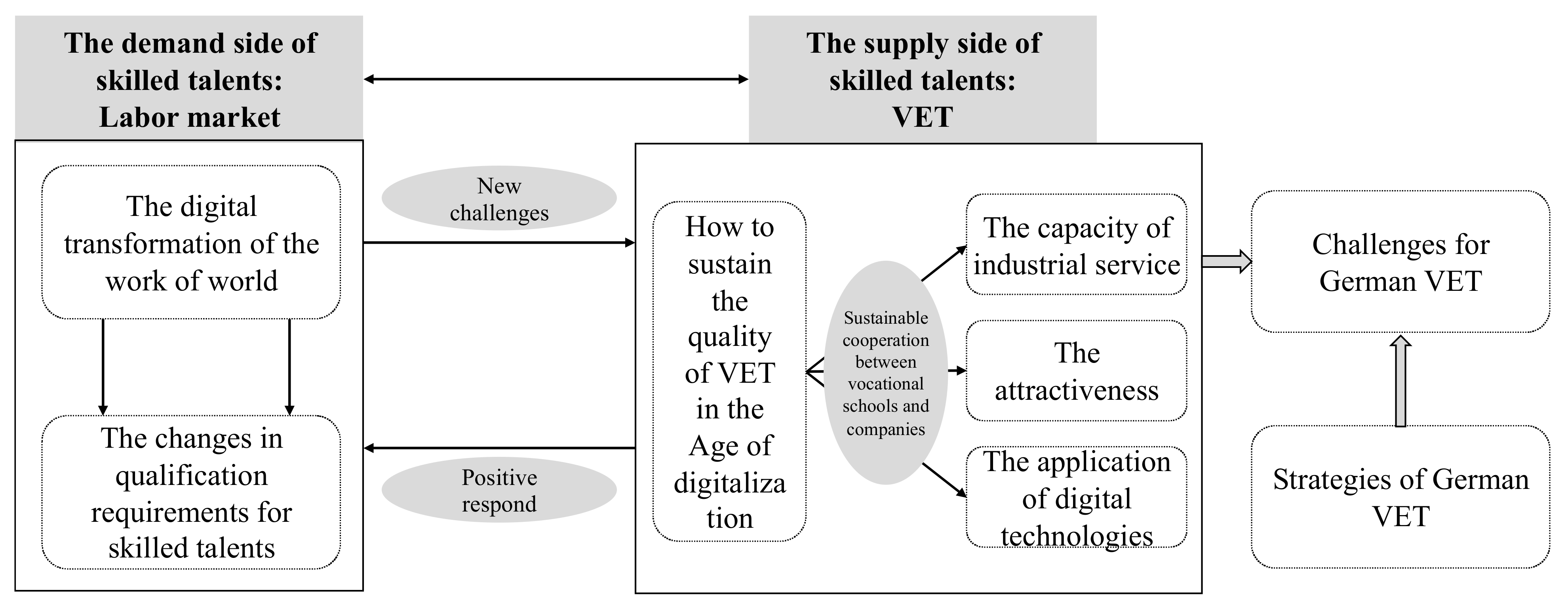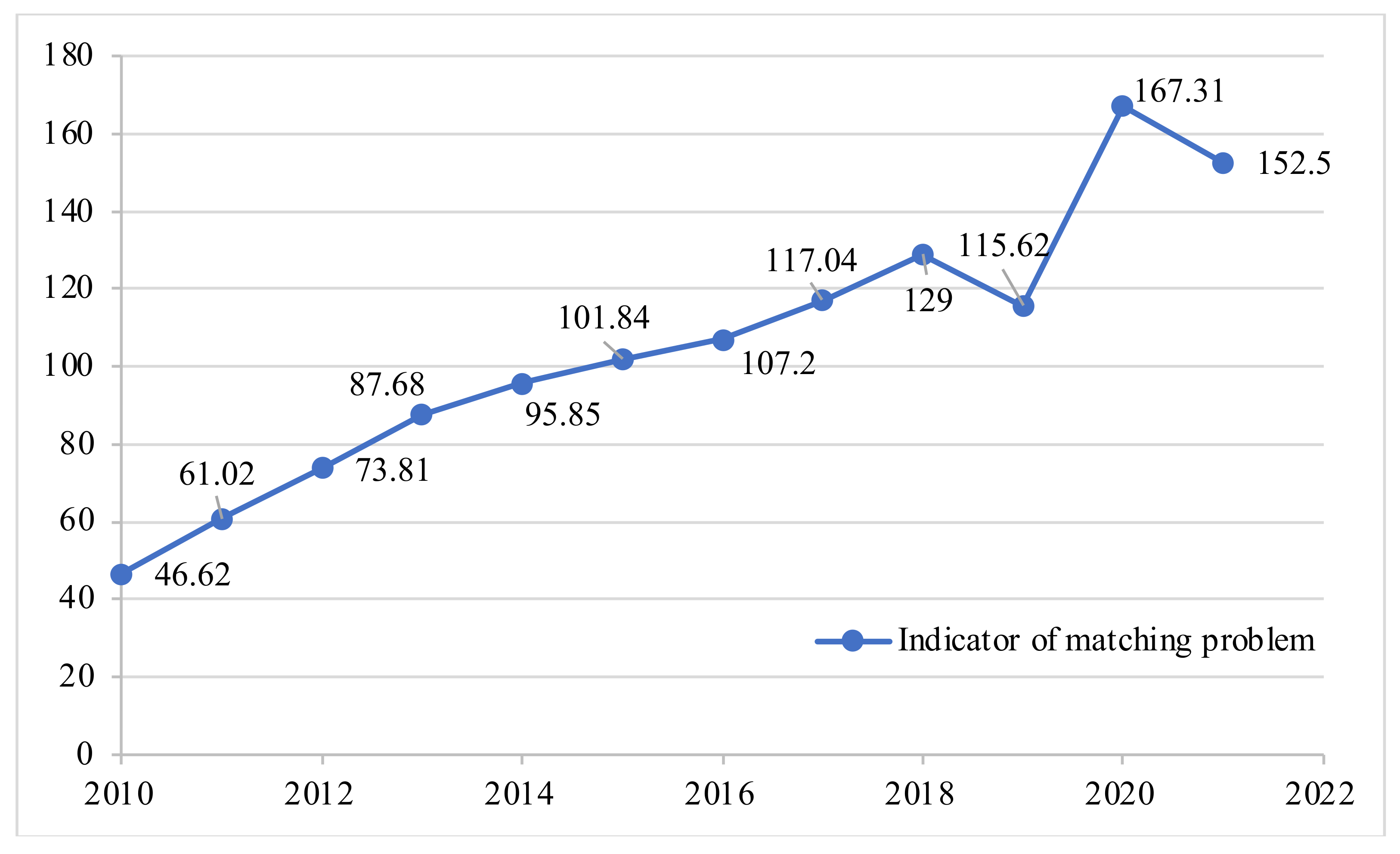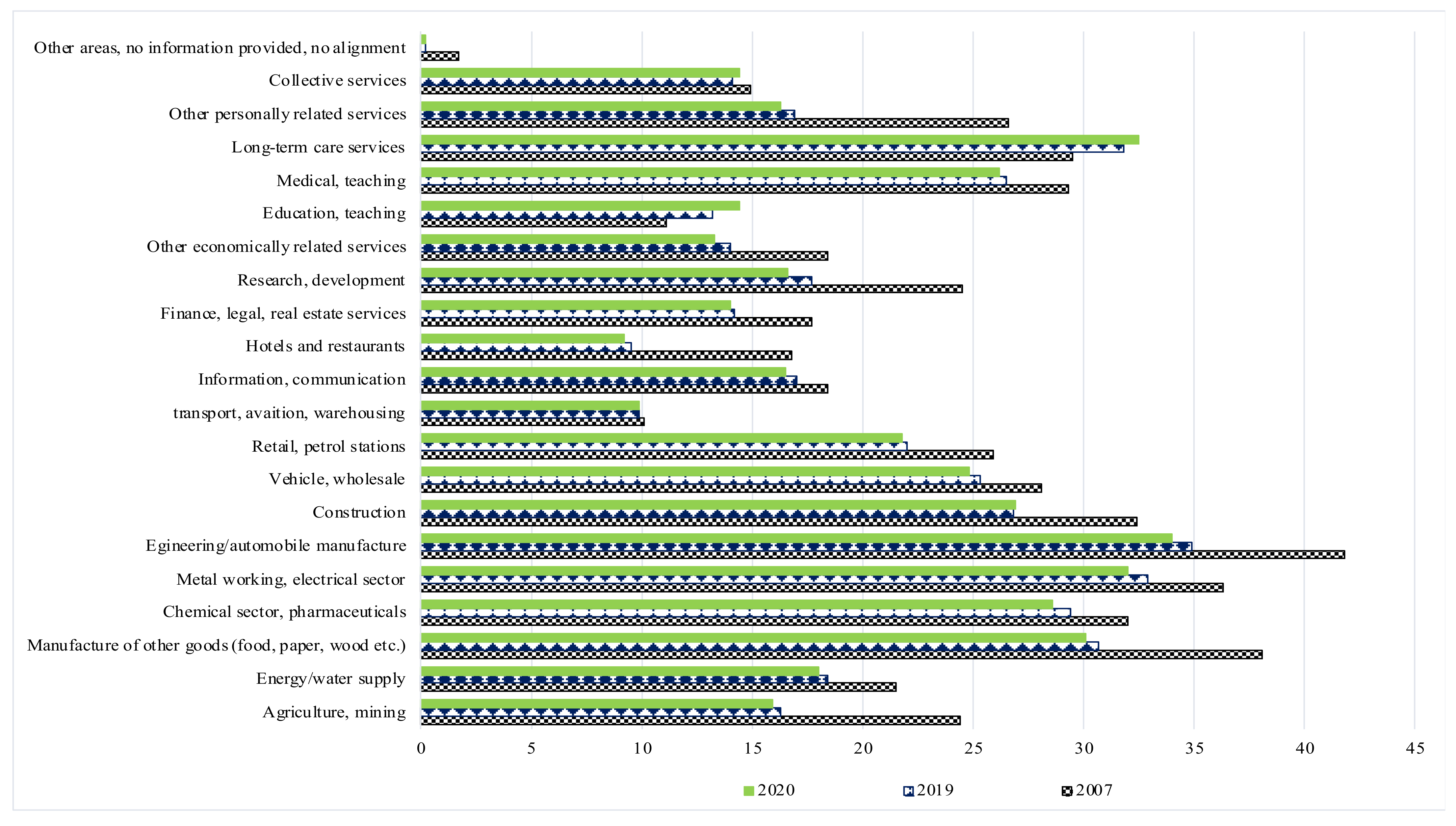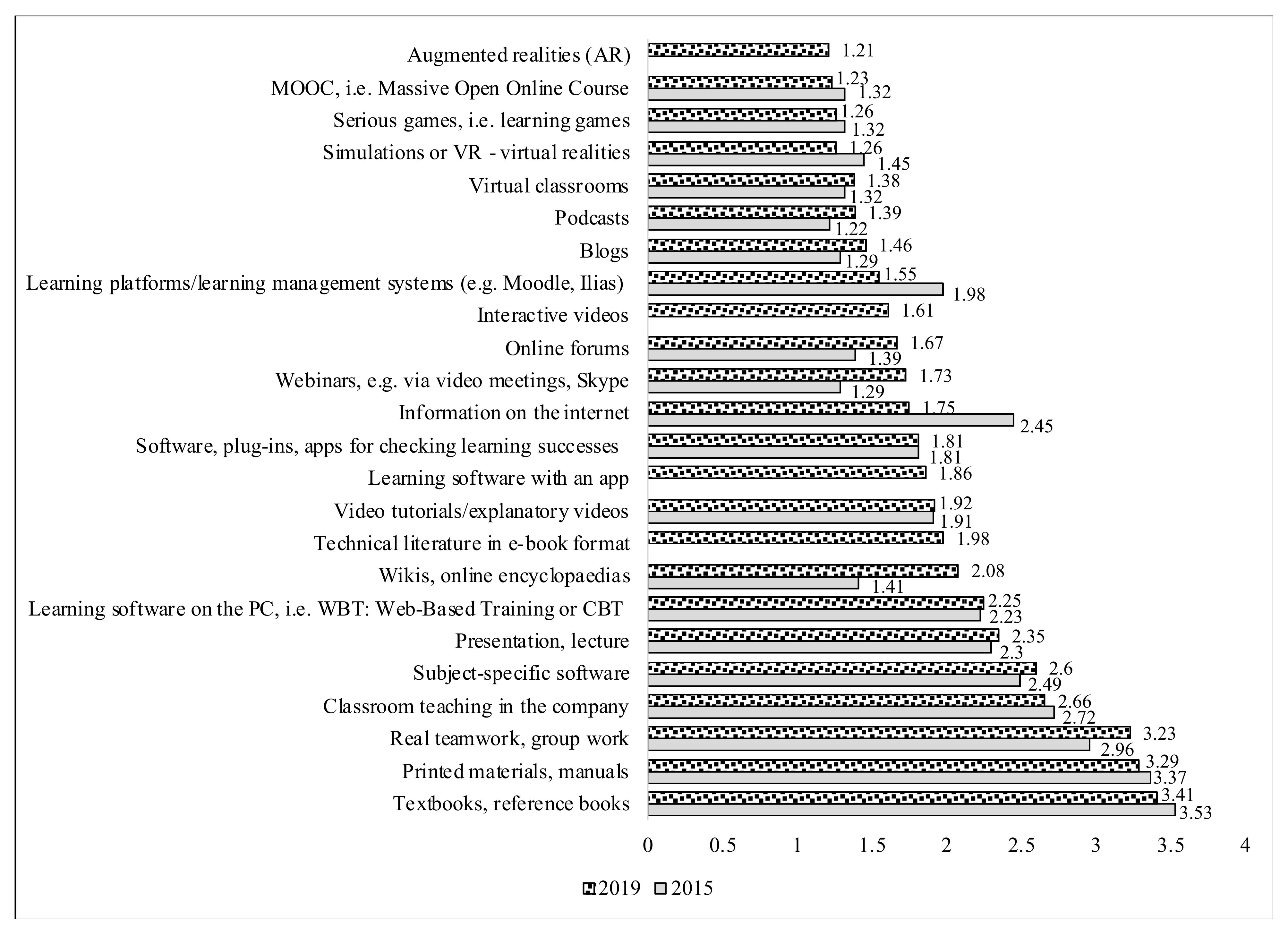Sustaining the Quality Development of German Vocational Education and Training in the Age of Digitalization: Challenges and Strategies
Abstract
1. Introduction
- (1)
- What are the challenges for German VET to sustain quality development in the context of digitalization?
- (2)
- What reform and innovation strategies has German VET adopted to tackle these challenges?
2. Literature Review
2.1. Digital Transformation of the World of Work: Characteristics and Qualification Requirements
2.2. German VET in the Digitized World of Work
3. Sustainable Cooperation between Vocational Schools and Companies as a Conceptual Framework
4. Methodology
4.1. Data Collection
4.2. Data Analysis
5. Findings and Discussion
5.1. Question 1: What Are the Challenges for German VET to Sustain Quality Development in the Context of Digitalization?
5.1.1. The Capacity of German VET for Industrial Service Needs to Be Further Improved
5.1.2. The Attractiveness of German VET Is on the Decline
5.1.3. The Application Level of Digital Technologies in VET Needs to Be Enhanced
5.2. Question 2: What Reform and Innovation Strategies Has German VET Taken to Tackle These Challenges?
5.2.1. Strengthening the Capability of Training Digital Talents through the Modernization of Training Regulations and Skeleton Curricula
5.2.2. Reshaping VET as a More Promising Track for Individuals through Information Support and Expanding Development Pathways
5.2.3. Enhancing the Participation Willingness and the Capacity to Provide Vocational Training of Companies through Financial Measures
5.2.4. Promoting the Digital Transformation of VET through Comprehensive Strategies
6. Conclusions
Author Contributions
Funding
Institutional Review Board Statement
Informed Consent Statement
Data Availability Statement
Conflicts of Interest
Appendix A
| No. | Year | Issuing Unit | Name | Language | Source |
|---|---|---|---|---|---|
| Data Reports | |||||
| 1 | 2022 | BIBB | VET Data Report Germany 2022 | German | https://www.bibb.de/dienst/veroeffentlichungen/en/publication/show/18019 (accessed on 18 November 2022) |
| 2 | 2021 | BIBB | VET Data Report Germany 2021 | German | https://www.bibb.de/dienst/veroeffentlichungen/en/publication/show/17483 (accessed on 26 September 2022) |
| 3 | 2020 | BIBB | VET Data Report Germany 2020 | German | https://www.bibb.de/dienst/veroeffentlichungen/en/publication/show/16673 (accessed on 11 September 2022) |
| 4 | 2020 | BIBB | Digital media in companies—today and tomorrow 2020 | German | https://www.bibb.de/dienst/veroeffentlichungen/en/publication/show/16751 (accessed on 10 September 2022) |
| 5 | 2022 | BIBB | VET Data Report Germany 2019 | English | https://www.bibb.de/dienst/veroeffentlichungen/en/publication/show/17930 (accessed on 22 November 2022) |
| 6 | 2018 | BIBB | VET Data Report Germany 2016/2017 | English | https://www.bibb.de/dienst/veroeffentlichungen/en/publication/show/9550 (accessed on 5 September 2022) |
| 7 | 2016 | BIBB | Digital media in companies—today and tomorrow 2016 | German | https://www.bibb.de/dienst/veroeffentlichungen/de/publication/show/8048 (accessed on 5 September 2022) |
| 8 | 2022 | BMBF | Report on Vocational Education and Training 2021 | English | https://www.bmbf.de/SharedDocs/Publikationen/de/bmbf/FS/31702_Berufsbildungsbericht_2021_en.pdf?__blob=publicationFile&v=3 (accessed on 5 September 2022) |
| 9 | 2019 | BMBF | Report on Vocational Education and Training 2019 | English | https://www.bmbf.de/SharedDocs/Publikationen/de/bmbf/FS/31568_Berufsbildungsbericht_2019_en.pdf?__blob=publicationFile&v=7 (accessed on 5 September 2022) |
| 10 | 2022 | EC | Digital Economy and Society Index (DESI) 2022-Germany | English | https://ec.europa.eu/newsroom/dae/redirection/document/88702 (accessed on 5 August 2022) |
| 11 | 2021 | EC | Digital Economy and Society Index (DESI) 2021-Germany | English | https://ec.europa.eu/newsroom/dae/redirection/document/80481 (accessed on 5 August 2022) |
| 12 | 2020 | EC | Digital Economy and Society Index (DESI) 2020-Germany | English | https://ec.europa.eu/newsroom/dae/redirection/document/66916 (accessed on 5 August 2022) |
| Research Reports | |||||
| 1 | 2020 | Cedefop | Spotlight on VET-Germany | English | https://www.cedefop.europa.eu/en/publications-and-resources/publications/8137 (accessed on 16 August 2022) |
| 2 | 2020 | Cedefop | Vocational education and training in Germany: short description | English | http://data.europa.eu/doi/10.2801/329932 (accessed on 16 August 2022) |
| 3 | 2020 | BIBB | VET 4.0—Is vocational education and training on the edge of radical change? | German | https://www.bibb.de/dienst/veroeffentlichungen/de/publication/show/16425 (accessed on 16 August 2022) |
| 4 | 2019 | BIBB | VET 4.0—Skilled worker qualifications and competencies for the digitalized work of tomorrow: Sector and occupation screening | German | https://www.bibb.de/dienst/veroeffentlichungen/de/publication/show/10371 (accessed on 19 August 2022) |
| 5 | 2019 | Platform VET-4.0 | The 4th industrial revolution and it’s implication to the VET provision | English | https://www.ifoa.it/wp-content/uploads/2019/02/VET-4.0-Research-Report.pdf (accessed on 19 August 2022) |
| 6 | 2020 | BMBF | Inter-company training—modern, digital, and attractive | English | https://www.bmbf.de/SharedDocs/Publikationen/de/bmbf/FS/31632_Ueberbetriebliche_Ausbildung_en.html (accessed on 19 August 2022) |
| Policies | |||||
| 1 | 2019a | BMBF | Digital Future: Learn. Research. Knowledge | German | https://www.bmbf.de/upload_filestore/pub/BMBF_ Digitalstrateg.pdf (accessed on 9 August 2022) |
| 2 | 2019b | BMBF | The Vocational Education and Training Act (BBiG) | German | https://www.bmbf.de/bmbf/de/home/_documents/die-novellierung-des-berufsbildungsgesetzes-bbig.html (accessed on 9 August 2022) |
| 3 | 2016a | BMBF | Education initiative for the digital knowledge society | German | https://www.bildungforschung.digital/de/einebildungsoffensive-fuer-die-digitalewissensgesellschaft-1715.html (accessed on 9 August 2022) |
| 4 | 2016b | BMBF | Digital media in vocational education and training | German | https://www.bmbf.de/de/digitale-medien-in-der-bildung-1380.html (accessed on 13 August 2022) |
| 5 | 2016 | KMK | Education in the digital world | German | https://www.kmk.org/fileadmin/Dateien/veroeffentlichungen_beschluesse/2016/2016_12_08-Bildung-in-der-digitalen-Welt.pdf (accessed on 13 August 2022) |
| 6 | 2017 | KMK | Vocational schools 4.0 | German | https://www.kmk.org/fileadmin/user_upload/Erklaerung_Berufliche_Schulen_4.0_-_Endfassung.pdf (accessed on 13 August 2022) |
| 7 | 2019 | KMK | Framework agreement on the vocational school | German | http://www.kmk.org/fileadmin/Dateien/veroeffentlichungen_beschluesse/2002/2002_11_07-RV-Fachschulen.pdf (accessed on 13 August 2022) |
| 8 | 2017 | KMK, BDA and DGB | Together for powerful vocational schools in the digital world | German | https://www.kmk.org/fileadmin/Dateien/pdf/PresseUndAktuelles/2017/2017-05-30_Gem._Erklaerung_KMK-DGB-BDA.pdf (accessed on 19 August 2022) |
| 9 | 2016 | BMWi | Digital Strategy 2025 | English | https://www.bmwi.de/Redaktion/EN/Publikationen/digitale-strategie-2025.html (accessed on 19 August 2022) |
| 10 | 2019 | BMAS and BMBF | National Skills Strategy | English | https://www.bmas.de/EN/Our-Topics/Initial-and-Continuing-Training/national-skillsstrategy.html (accessed on 19 August 2022) |
| 11 | 2017 | BMAS | White Paper: Work 4.0 | English | https://www.bmas.de/EN/Services/Publications/a883-white-paper.html (accessed on 20 August 2022) |
| 12 | 2015 | BMAS | Green Paper: Work 4.0 | English | https://www.bmas.de/EN/Services/Publications/arbeiten-4-0-greenpaper-work-4-0.html (accessed on 20 August 2022) |
| 13 | 2021 | BIBB | The modernized standard occupational profile positions of recognized training occupations | German | https://www.bibb.de/dienst/publikationen/de/download/17281 (accessed on 22 August 2022) |
References
- Achtenhagen, C.; Achtenhagen, L. The impact of digital technologies on vocational education and training needs—An exploratory study in the Germany food industry. Educ. Train. 2019, 2, 222–233. [Google Scholar] [CrossRef]
- Caruncho, V.F. Effects of the COVID-19 Pandemic on Young People during the Transition from School to Training and Work in Germany. In Effects of the COVID-19 Pandemic on Vocational Education and Training: International Perspectives of Policy Makers and Practitioners; BIBB: Bonn, Germany, 2022. [Google Scholar]
- World Economic Forum. The Future of Jobs Report 2020. 2020. Available online: https://www3.weforum.org/docs/WEF_Future_of_Jobs_2020.pdf (accessed on 16 January 2022).
- Kaiser, F. Berufsbildung im Strudel von Megatrends der Transformationsgesellschaft. In Berufsbildung; WEF: Cologny, Switzerland, 2020; Volume 186, pp. 3–6. [Google Scholar]
- DIHK. Economic Survey Autumn 2019 (Konjunkturumfrage Herbst 2019). 2019. Available online: https://www.aserbaidschan.ahk.de/marktinformation/publikationen/dihk-konjunkturumfrage/dihk-konjunkturumfrage-herbst-2019 (accessed on 21 December 2021).
- BMWK. Skilled Professionals for Germany. 2019. Available online: https://www.bmwk.de/Redaktion/EN/Dossier/skilled-professionals.html (accessed on 14 December 2021).
- Germany Federal Government. High-Tec Strategy 2025. 2018. Available online: https://www.bmbf.de/SharedDocs/Publikationen/de/bmbf/FS/31538_Forschung_und_Innovation_fuer_die_Menschen_en.pdf?__blob=publicationFile&v=7 (accessed on 16 December 2021).
- Wolter, A.; Kerst, C. The “academization” of the German qualification system: Recent developments in the relationships between vocational training and higher education in Germany. Res. Comp. Int. Educ. 2015, 4, 510–524. [Google Scholar] [CrossRef]
- Esser, F.H. Digitalization and AI Are Conductive to Increasing the Attractiveness of Vocational Education and Training. In Vocational Training in Research and Practice: VET Trends 2019, Special Edition; BIBB: Bonn, Germany, 2019; Volume 3, p. 4. [Google Scholar]
- He, Z.; Li, Y.Z.; Wei, M. The Institutional Innovation of Industry-Education Integration in Vocation Education; Science Press: Beijing, China, 2018. [Google Scholar]
- Liu, L.X. Germany’s strategy and actions to promote the construction of Vocational Education 4.0. Chin. Vocat. Tech. Educ. 2018, 13, 20–28. [Google Scholar]
- Schröder, T. A regional approach for the development of TVET systems in the light of the 4th industrial revolution: The regional association of vocational and technical education in Asia. Int. J. Train. Res. 2019, 1, 83–95. [Google Scholar] [CrossRef]
- Spöttl, G.; Gorldt, C.; Windelband, L.; Grantz, T.; Richter, T. Industrie 4.0—Auswirkungen auf Ausund Weiterbildung in der M + E Industrie. 2016. Available online: https://www.baymevbm.de/Redaktion/Frei-zugaengliche-Medien/Abteilungen-GS/Bildung/2016/Downloads/baymevbm_Studie_Industrie-4-0.pdf (accessed on 16 December 2021).
- Berger, T.; Frey, C.B. Digitalization, Jobs, and Convergence in Europe: Strategies for Closing the Skills Gap. The Oxford Martin School Research Report. 2016. Available online: https://www.oxfordmartin.ox.ac.uk/downloads/reports/SCALE_Digitalisation_Final.pdf (accessed on 13 December 2021).
- Schumpeter, J.A. Capitalism, Socialism and Democracy; Taylor & Francis: New York, NY, USA, 1942. [Google Scholar]
- Wolter, M.I.; Mönnig, A.; Schneemann, C.; Weber, E.; Zika, G.; Helmrich, R.; Maier, T.; Winnige, S. Wirtschaft 4.0 und die Folgen für Arbeitsmarkt und Ökonomie; BIBB: Bonn, Germany, 2019. [Google Scholar]
- Spath, D.; Ganschar, O.; Gerlach, S.; Hämmerle, M.; Krause, T.; Schlund, S. Production Work of the Future: Industry 4.0 (Produktionsarbeit der Zukunft: Industrie 4.0). Available online: http://sf-eu.net/wp-content/uploads/2016/08/fraunhofer-iao-2013-studie-produktionsarbeit-der-zukunft-industrie-4.0-de.pdf (accessed on 27 December 2021).
- Bobkov, V.N.; Simonova, M.V.; Chernykh, E.A. Platform Employment: From Unsustainable to Sustainable Development. In Digital Technologies in the New Socio-Economic Reality; Ashmarina, S.I., Mantulenko, V.V., Eds.; Springer: Cham, Switzerland, 2022; pp. 139–147. [Google Scholar]
- Drahokoupil, J.; Piasna, A. Work in the platform economy: Beyond lower transaction costs. Intereconomics 2017, 52, 335–340. [Google Scholar] [CrossRef]
- World Economic Forum. Closing the Skills Gap Accelerators-the Sub-Project of the World Economic Forum’s Shaping the Future of the New Economy and Society. 2019. Available online: https://skillssummit.co.za/closing-the-skills-gap-accelerators/ (accessed on 16 December 2021).
- Hirsch-Kreinsen, H.; Weyer, J.; Wilkesmann, M. Digitalisierung von Arbeit: Folgen, Grenzen und Perspektiven. 2015. Available online: http://www.forschungsnetzwerk.at/downloadpub/20151015-Hirsch-Kreinsen-2015-Digitalisierung-von-Arbeit-Soz-Arbeitspapier.pdf (accessed on 23 December 2021).
- Goos, M.; Manning, A.; Salomons, A. Explaining job polarization: Routine-biased technological change and offshoring. Am. Econ. Rev. 2014, 8, 2509–2526. [Google Scholar] [CrossRef]
- Graf, L.; Lohse, A.P. Advanced Skill Formation between Vocationalization and Academization: The Governance of Professional Schools and Dual Study Programs in Germany. In Governance Revisited—Challenges and Opportunities for Vocational Education and Training; Peter Lang: Bern, Switzerland, 2021; pp. 215–242. [Google Scholar]
- Veres, M.M.; Veres, C.; Rauca, A.M.; Marian, L.O.; Sigmirean, A. Research on Qualified Vocational Training Development in the Context of Digitalization. Proceedings 2020, 63, 68. [Google Scholar]
- Brolpito, A. Digital Skills and Competence, and Digital and Online Learning. European Training Foundation Research Paper. 2018. Available online: https://www.etf.europa.eu/sites/default/files/2018-10/DSC%20and%20DOL_0.pdf (accessed on 15 December 2021).
- Dücker, S.; Schapfel-Kaiser, F.; BIBB. IT Technology in Vocational Education—A Matter of Fact Today. 2006. Available online: https://www.bibb.de/en/16630.php (accessed on 28 December 2022).
- Seyffer, S.; Hochmuth, M.; Frey, A. Challenges of the Coronavirus Pandemic as an Opportunity for Sustainable Digital Learning in Vocational Education and Training (VET). Sustainability 2022, 14, 7692. [Google Scholar] [CrossRef]
- Hackel, M.; Junggeburth, C.; Milolaza, A.; Reymers, M.; Zöller, M. Berufsschule im dualen System–Daten, Strukturen, Konzepte; BIBB: Bonn, Germany, 2017; Available online: https://www.bibb.de/dienst/dapro/daprodocs/pdf/eb_42482.pdf (accessed on 15 December 2021).
- Attwell, G.; Rauner, F. Training and development in Germany. Int. J. Train. Dev. 2022, 3, 227–233. [Google Scholar] [CrossRef]
- Ertl, H. Dual study programmes in Germany: Blurring the boundaries between higher education and vocational training? Oxf. Rev. Educ. 2020, 1, 79–95. [Google Scholar] [CrossRef]
- Kitiashvili, A.; Sumbadze, N. Overcoming Vocational Stereotypes—A Step towards Raising the Attractiveness of Vocational Education and Training in Georgia. Educ. Sci. Psychol. 2018, 49, 51–62. [Google Scholar]
- Anselmann, S.; Harm, S.; Faßhauer, U. Input From the Grassroots Level—Reflecting Challenges and Problems for VET Professionals in Germany. Int. J. Res. Vocat. Educ. Train. 2022, 2, 239–268. [Google Scholar] [CrossRef]
- Baethge, M.; Severing, E.; Weiß, R. Handlungsstrategien für die Berufliche Weiterbildung; BIBB Publications: Bonn, Germany, 2013. [Google Scholar]
- DGB Jugend. Corona Ausbildungsstudie. Sonderstudie zu den Auswirkungen der Corona-Krise auf die Duale Berufsausbildung. Available online: file:///Users/yangchengming/Downloads/Corona-Ausbildungsstudie%20(1).pdf (accessed on 26 December 2021).
- Robert Bosch Stiftung. Unterricht Besser Machen. Die Nominierten Schulen des Deutschen Schulpreises 2022. Available online: https://www.bosch-stiftung.de/sites/default/files/publications/pdf/2022-10/Deutscher_Schulpreis_22_Unterricht_besser_machen.pdf (accessed on 26 October 2021).
- Weiss, R. Vocational Education & Training 4.0. Available online: https://www.bibb.de/en/25228.php (accessed on 26 October 2021).
- Dietl, S.; Hennecke, M. Ausbildung 4.0: Digitale Transformation in der Berufsausbildung Gestalten und Nutzen; Haufe-Lexware: Freiburg, Germany, 2019. [Google Scholar]
- Anisimova, A.N.; Efremova, Y.I. Digital Transformation of Vocational Education: Challenges of Modern Society. In Digital Technologies in the New Socio-Economic Reality; Ashmarina, S.I., Mantulenko, V.V., Eds.; Springer: Cham, Switzerland, 2022; pp. 773–781. [Google Scholar]
- Deissinger, T. Germany’s system of vocational education and training: Challenges and modernization issues. Int. J. Train. Res. 2014, 1, 76–99. [Google Scholar] [CrossRef]
- Deissinger, T. Problems and Challenges of Full-Time and School-Based VET in Germany. In New Frontiers for College Education: International Perspectives; Routledge: London, UK, 2019; pp. 148–164. [Google Scholar]
- Farías, M.; Sevilla, M.P. Effectiveness of Vocational High Schools in Students’ Access to and Persistence in Postsecondary Vocational Education. Res. High Educ. 2015, 56, 693–718. [Google Scholar] [CrossRef]
- Lasonen, J.; Gordon, J. Improving the Attractiveness and Image of VET. Available online: https://www.cedefop.europa.eu/files/01-Lasonen.pdf (accessed on 22 December 2021).
- European Commission. Directorate-General for Employment, Social Affairs and Inclusion. High-Performance Apprenticeships & Work-Based Learning: 20 Guiding Principles. Available online: https://ec.europa.eu/social/BlobServlet?docId=14881&langId=en (accessed on 8 December 2021).
- Solga, H.; Protsch, P.; Ebner, C.; Brzinsky-Fay, C. The German Vocational Education and Training System: Its Institutional Configuration, Strengths, and Challenges. Available online: https://bibliothek.wzb.eu/pdf/2014/i14-502.pdf (accessed on 30 December 2021).
- Wuttke, E.; Seifried, J.; Niegemann, H. Vocational Education and Training in the Age of Digitization—Challenges and Opportunities; Barbara Budrich Publishers: Opladen, Germany, 2020. [Google Scholar]
- UNESCO-UNEVOC. Digital Skills Development in TVET Teacher Training; UNESCO-UNEVOC: Bonn, Germany, 2022. [Google Scholar]
- Haasler, S.R. The German system of vocational education and training: Challenges of gender, academisation and the integration of low-achieving youth. Transf. Eur. Rev. Labour Res. 2020, 1, 57–71. [Google Scholar] [CrossRef]
- Hökkä, P.; Vähäsantanein, K.; Paloniemi, S. Emotions in learning at work: A literature review. Vocat. Learn. 2020, 13, 1–25. [Google Scholar] [CrossRef]
- Sinclair, S.; Rockwell, G. Text Analysis and Visualization: Making Meaning Count. In A New Companion to Digital Humanities; John Wiley & Sons, Ltd.: New York, NY, USA, 2021; pp. 274–290. [Google Scholar]
- Corbin, J.M.; Strauss, A. Basics of Qualitative Research: Techniques and Procedures for Developing Grounded Theory, 4th ed.; SAGE Publications: London, UK, 2015. [Google Scholar]
- Flick, U.; von Kardorff, E.; Steinke, I. A Companion to Qualitative Research; SAGE Publications: London, UK, 2005. [Google Scholar]
- Maier, T.; Zika, G.; Kalinowski, M.; Mönnig, A.; Wolter, M.I.; Schneeman, C. Bevölkerungswachstum bei Geringer Erwerbslosigkeit--Ergebnisse der Fünften Welle der BIBB-IAB Qualifikations und Berufsprojektionen bis Zum Jahr 2035; BIBB: Bonn, Germany, 2018. [Google Scholar]
- Berger, K. Zur Handlungsorientierung von Betriebsräten in der Betrieblichen Berufsausbildung. 2013. Available online: https://www.bwpat.de/ausgabe/25/berger (accessed on 10 December 2022).
- Fernandez, V. Mit Flexiblen Lösungen Durch die Corona-Krise. Auswirkungen der Pandemie auf die Übergänge in Ausbildung und Beruf. 2020. Available online: https://www.ueberaus.de/wws/mit-flexiblen-loesungen-durch-die-corona-krise.php (accessed on 21 December 2021).
- Pilz, M.; Harris, R.; Zenner-Höffkes, L.; Zirkle, C. Undertaking Comparative VET Research in International Teams: The Example of Exploring Recruitment and Training Cultures in SMEs in Germany, Australia and the United States; Comparative Vocational Education Research; Springer VS: Wiesbaden, Germany, 2020; pp. 291–309. [Google Scholar]
- Benassi, C.; Durazzi, N.; Fortwengel, J. Not All Firms Are Created Equal: SMEs and Vocational Training in the UK, Italy, and Germany. Available online: https://www.econstor.eu/handle/10419/216201 (accessed on 13 January 2021).
- BIBB. Vier Sind Die Zukunft—Digitalisierung. Nachhaltigkeit. Recht. Sicherheit; BIBB: Bonn, Germany, 2021. [Google Scholar]
- BIBB. Training Regulation and How They Come About. Available online: https://www.bibb.de/veroeffentlichungen/en/publication/download/id/7324 (accessed on 19 December 2021).
- Han, K.; Trinkoff, A.M.; Storr, C.L.; Lerner, N.; Johantgen, M.; Gartrell, K. Associations between state regulations, training length, perceived quality and job satisfaction among certified nursing assistants: Cross-sectional secondary data analysis. Int. J. Nurs. Stud. 2014, 8, 1135–1141. [Google Scholar] [CrossRef]




| 2019 | 2021 | 2022 | ||
|---|---|---|---|---|
| Value (In %) | Value (In %) | Value (In %) | EU (In %) | |
| At least basic digital skills (% individuals) | 68 (2017) | 70 (2019) | 49 (2021) | 54 (2021) |
| Above basic digital skills (% individuals) | 37 (2017) | 39 (2019) | 19 (2021) | 26 (2021) |
| At least basic software skills (% individuals) | 70 (2017) | 72 (2019) | 65 (2021) | 66 (2021) |
| ICT specialists (% total employment) | 3.9 (2018) | 4.7 (2020) | 4.9 (2021) | 4.5 (2021) |
| Female ICT specialists (% female employment) | 17 (2018) | 18 (2020) | 19 (2021) | 19 (2021) |
| ICT graduates (% graduates) | 4.7 (2017) | 4.5 (2019) | 4.9 (2020) | 3.9 (2020) |
Disclaimer/Publisher’s Note: The statements, opinions and data contained in all publications are solely those of the individual author(s) and contributor(s) and not of MDPI and/or the editor(s). MDPI and/or the editor(s) disclaim responsibility for any injury to people or property resulting from any ideas, methods, instructions or products referred to in the content. |
© 2023 by the authors. Licensee MDPI, Basel, Switzerland. This article is an open access article distributed under the terms and conditions of the Creative Commons Attribution (CC BY) license (https://creativecommons.org/licenses/by/4.0/).
Share and Cite
Yang, C.; Kaiser, F.; Tang, H.; Chen, P.; Diao, J. Sustaining the Quality Development of German Vocational Education and Training in the Age of Digitalization: Challenges and Strategies. Sustainability 2023, 15, 3845. https://doi.org/10.3390/su15043845
Yang C, Kaiser F, Tang H, Chen P, Diao J. Sustaining the Quality Development of German Vocational Education and Training in the Age of Digitalization: Challenges and Strategies. Sustainability. 2023; 15(4):3845. https://doi.org/10.3390/su15043845
Chicago/Turabian StyleYang, Chengming, Franz Kaiser, Hui Tang, Pujun Chen, and Junfeng Diao. 2023. "Sustaining the Quality Development of German Vocational Education and Training in the Age of Digitalization: Challenges and Strategies" Sustainability 15, no. 4: 3845. https://doi.org/10.3390/su15043845
APA StyleYang, C., Kaiser, F., Tang, H., Chen, P., & Diao, J. (2023). Sustaining the Quality Development of German Vocational Education and Training in the Age of Digitalization: Challenges and Strategies. Sustainability, 15(4), 3845. https://doi.org/10.3390/su15043845




